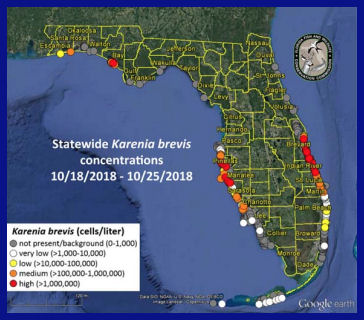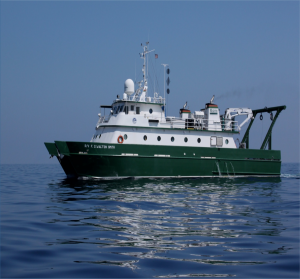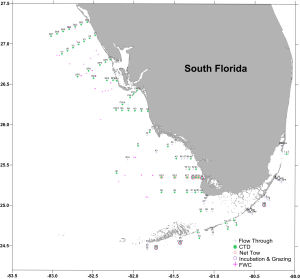Red Tide Water Quality Assessment Research Cruise
 |
During a series of late summer 2018 workshops with stakeholders on the southwest Florida coast, serious concerns were highlighted regarding the impacts of red tide not only on fish populations, but also on habitat, the commercial and for-hire fishing businesses, aquaculture, tourism and human health. Stakeholders have observed extensive habitat damage related to red tide, and have noted that recovery of fish populations has been increasingly delayed following recent and frequent red tides. A number of human health impacts were noted, including the direct effects of the Karenia brevis toxin as well as other bacterial infections which may be related to other pathogens associated with the bloom. Red tides are impacting not only the fish populations that commercial and for-hire fishing businesses are dependent upon, but other aspects of the fishing communities such as aquaculture activities, private recreational fishing, tourism visitation, local seafood markets, and real estate values. Through these additive and potentially synergistic effects, red tides can have far-reaching impacts on coastal communities.
NOAA's Atlantic Oceanographic and Meteorological Laboratory is conducting a South Florida Ecosystems research cruise aboard the R/V Walton Smith to help sample the ongoing red tide on the southwest Florida Shelf. The focus will be on quantifying human health and ecosystem impacts from the red tide event. The red tide research cruise was funded, in part, by the National Centers for Coastal Ocean Science (NCCOS) HAB Event Response Program. Read more about NCCOS participation in the ongoing Florida red tide response here.
Red Tide Water Quality Assessment
 |
 |
NOAA/AOML, NOAA/SEFSC, State of Florda Fish and Wildlife Research Institute, NOAA/NESDIS, USF, MOTE Marine Laboratory and Aguarium and University of Miami will conduct a survey of south Florida’s coastal waters on October 12-19, 2018 aboard the R/V Walton Smith. These cruises have been investigating coastal water quality in south Florida every other month since the late 1990s. This cruise is being enhanced and modified to better capture the response of south Florida coastal water quality to the current red tide event which is occuring in the southwest Florida shelf. The main objectives of this cruise are to 1) Quantify the impact of the red tide on coastal water quality along the Florida Keys and southwest Florida shelf, 2) Document the southern and offshore extent of the on-going red tide bloom, 3) Investigate bloom dynamics by quantifying Karenia brevis abundance (including during their time of division 12AM-4AM), 4) Investigate Ecosystem Impacts of the bloom by a) conducting CTDs with Dissolved Oxygen profiles, b) re-occupying FWRI camera survey sites to do BACI analysis, c) conducting ROV surveys of benthic habitat and dead fauna on the bottom, d) document species assemblages in mortality events and length or age of the fish for inputs into stock assessment, e) collect fish tissue for histopathology, f) document protected species (turtles and mammals) occurence and condition and collect mammal tissue samples and 5) Calibrate satellite measurements to be post-processed to provide a time-series of the red tide impacts on south Florida coastal waters. Parameters to be collected at each station or measured underway include Dissolved Inorganic Nutrients, Salinity, Temperature, Chlorophyll a, Dissolved Oxygen profiles, Dissolved Inorganic Carbon, and fCO2. At select stations, we will also collect samples to measure environmental DNA and Primary Productivity. We will be posting updates from the cruise as the internet on board and timing allow.
- Click here to see Preliminary Results
- Click here to see Cruise Participants
- Click here to see Cruise Updates
- Click here to see NOAA Ocean Service Red Tide in Florida and Texas website
- Click here to see WINK News Article "Red Tide One Year Later"
- DATES: October 12-19, 2018
- GEORGRAPHIC AREA: Southwest Florida Shelf
- OBJECTIVES:
- Quantify human health and ecosystem impacts from the red tide
- PARAMETERS:
- Seagrass percent cover
- Juvenile sportfish abundances
- Juvenile and small adult fish collections
- YSI exosonde water quality data
- Chlorophyll a
- Dissolved Inorganic Nutrients
- Salinity
- Temmperature
- Dissolved Oxygen Profiles
- Dissolved Inorganic Carbon and fCO2